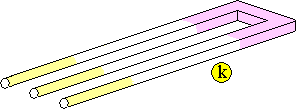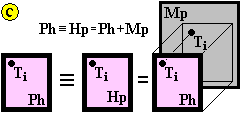|
 |
|
|
HYPERphysical Materialism |
"... as soon as I have got concepts ... differing from principles,
which have been used till now,a a a a a a a a a a a a a a a
I have decided, that I cannot conceal them,a a a a a a
without sinning against the law, which requires ...
to promote general prosperity of all people "
Rene Descartes
|
The STRUCTURE of MATTER
è
| 1. Any physical object Ti
| (i.e. an object existing in the physical reality, in physicum Ph) |
is in fact a hyperphysical object TÍp
|
(i.e. in fact it exists in hyperphysical reality, in hyperphysicum Íp),
|
because both its components – the physical TPh and the metaphysical TMp
(i.e. a component existing in the metaphysical reality, in metaphysicum Ìp). |
– are equally inherent to Ti (fig. à).
| | 
|
Substantiation.
A part of TMp is the information iT about Ti, at least – about its (Ti) existence. Three facts concerning this iT must be noted –
(1) it is real, objective; its existence is real not less, than existence of TPh, and, hence, iT is a material object, since (by definition) any reality, which exists ontologically, objectively
(i.e. independently on existence of other realities, in particular on existence of an observer or a researcher of the given, considered reality),
|
is a material object;
(2) this object is not physical and, hence, is metaphysical.
For practical needs, in particular – in computer engineering, the notion of information is substituted with the notion of a code bearing some information.
But even a code is not a completely, “cleanly” physical object. A code itself, without its coding language, loses its information, it ceases to be a code.
And language is a set of rules for codings-decodings of information. A rule is not a physical object;
(3) TPh and iT (as well as TMp, a part of which iT is) are the same, the one and indivisible object TÍp; object iT (as well as any information) can be copied (in particular, such a copy can become a part of our consciousness, and then we know about Ti existence), but Ti cannot lose iT (the information of itself); iT inheres in Ti, is attributive to Ti.
Graphic interpretation (fig. à) of this thesis is justified, because each object Ti can be depicted by a separate point on a scheme (a figure), representing the physical reality, physicum Ph,
i.e. a figure, representing the totality of all physical objects;
even if this totality is infinite, the density of multitude of points of a figure,
representing Ph on a scheme, is not lower than density of multitude of Ph objects.
|
2. But not each metaphysical object TMp has an object TPh corresponding to it in physicum Ph.
So, you can think of an elephant with graceful wings, but this thought will remain only the metaphysical object TMp, it cannot become the hyperphysical object because of absence of its physical component: such an elephant does not exist in physicum Ph.
So, and another object (fig. k), created by an imagination,
| |
 
|
cannot be realized physically.
Therefore (though not only by this reason) metaphysicum Mp is more extensive, richer than physicum Ph; therefore Mp covers Ph (fig. b).
Therefore the scheme (a) of matter structure should be made more precise (fig. c).
| | 
|
3. Ìetaphysicum Mp is not a homogeneous reality. It consists of two qualitatively different realities, both are metaphysical. We'll name one of them as mentalum (M) (the traditional, esoteric, occult science names it mental), another will be named astralum (À) (instead of astral).
The main distinction between mentalum and astralum is that M-objects possess only information. The mentalum nature is inherent to such (for example) elements of human psyche, as thoughts, abstractions, ideas. A-objects possess also (except of information) spatial properties: in particular – localization, extention, form. The astralum nature is inherent (for example) to other elements of psyche, in particular to images (in particular to perception images), emotions; and these elements are peculiar not only to human psyche, animals possess them too.
Unlike these two categories of objects, inertia is the distinctive feature of physical objects; they possess mass; the power objects (radiations and force fields) possess the mass of movement; substance (objects, things) possess the mass of immobility as well.
The note 1.
In pre-Lenin philosophy – i.e. before 1909 year, when his Ì&EC [ 67 ] was published – just the substance and only substance was admitted as matter, and at that without any substantiations ("by default"); the science had no correct definition of the notion of matter.
For example, French encyclopaedist Paul-Henri D. Holbach (1723-89) began his definition of the concept of matter (1770) with a remark which evidences of its (the definition) subjectivity, unscientificness, non-objectivity [ 27a ]: "in relation to us the matter is all that influences somehow upon our feelings (accentuations are mine – À.Ì.)". In fact feelings are not unitary (everyone feels in his own way) and are not universal (abilities of sense organs are rather limited).
Lenin has introduced the definition of matter as objective reality in order to give the status of materiality to energy, to electricity, which has replaced the representation about atom as the base of all matter in general, in connexion with inner atom’s structure discovery – the newest discovery for that time.
The definition has been introduced guardedly, with reservations, not as ontological concept (“the objective reality”), but only as gnosiological one (“the philosophical category”), but it has been introduced! And it has been expanded due to inclusion of physical kinds of energy in it.
The note 2.
The materialism, which is named today as dialectic one, is both inconsistent and self-limited.
• Inconsistency (an internal discrepancy).
•• On the one hand, it admits as matter any ( all ! ) objective reality, i.e. reality, the fact of which existence does not depend on existence of other realities, in particular on existence of its observer, witness, researcher – on existence of a subject. It is by Lenin.
•• On the other hand, it admits as matter only a part of an objective reality, namely only the physical reality, physicum. And it is by Lenin too.
This internal discrepancy remains not eliminated almost 100 years despite of unprecedented science successes during just these latest decades.
Why Lenin has let this internal discrepancy in his conceptual constructions is a question rather far from a strict science, it is a question of politics area. However there is not only Lenin's fault in this discrepancy, but – a paradox! – also his merit: before Ì&EC publication the science had no precise definition for matter at all, like as today NAS does not know what psyche is, so the discrepancy could merely not arise before.
The Lenin's formula Matter is primary, consciousness is secondary contradicts to the Rene Descartes' (Cartesius, 1596-1650) thesis Cogito ergo sum (I think, hence I exist), which actually confirms the primarity (primordial importance) of consciousness. But the main in this formula is not what is primary and what secondary. The main importance is that the whole reality is divided, is cut by this formula (this – precisely after Descartes) into extremes – "material" and "ideal". And this division is quite arbitrary for the fact of existence of "ideal" (in particular, of your thought) depends on existence of any exterior subject no more than the fact of existence of "material" (in particular, of your body).
• Self-limitation.
Descartes has ushered, introduced into the science the concept of extension as a criterion for distinction of material (actually – of physical, substantial) from ideal, has introduced the rigid opposition between Being (actually – physicum) and consciousnesses (actually – spirit).
By this Descartes has actually, by default, excluded a possibility of existence of any third reality, and also has excluded a possibility for any physical object to be a possessor of metaphysical properties. He has created a gap between ideal (actually – mentalum M) and material (actually – physicum Ph), has deprived them of intermediate material connecting-link. He (and after him Lenin too) did not admit the possibility of existence of something not physical, which has spatial properties (extention). But astralum (A) is just the reality of such very kind, and the special paradoxicallity of the situation (its funny side, its comicality) is that space (as well as time) is NON-physical itself, i.e. is metaphysical.
The note 3.
Space is conceived as physical one only because it contains physical objects. Space is an objective reality, so it is material, but it is a background of physicum, it is an attribute of physicum elements, but is not a physicum element.
It is impossible even in one's mind to tear off a measuring ruler from its length. Therefore the length (an element of space) is an attribute of physicum, is its inevitable factor, characteristic.
It is possible only in one's mind (not physically!) to tear off the length of a ruler from its body (from a physicum element), from those atoms of which the ruler consists. But this (torn off) length would already be not a length itself, but an idea on the length, thought about length. The idea is already an element not of physicum, but of another hypersubstance, of mentalum. Space is perceptible physically only due to presence of physical objects in it (not excluding a perceptive subject himself), like as a bagel hole is perceptible only at presence of a bagel itself.
The note 4.
The hyperphysical materialism makes the further (after Lenin's one) expansion of the matter concept, now due to inclusion in it of nonphysical energy (astralum) and information (mentalum); at that this expansion is made not contrary to the Lenin's definition of matter at all, but in strict conformity with it. And so the internal discrepancy of dialectic materialism is eliminated. At that hyperphysical materialism does not cease to be dialectic. It covers dialectic materialism just as Lobachevsky's geometry covers Euclid's geometry.
|
4.
Each astralum object TA
|
(i.e. an object existing in astralum A)
|
|
is actually a metaphysicum object TMp |
(i.e. it exists actually in metaphysicum Mp), |
|
because both its components – astralum one TA and mentalum one TM |
(i.e. a component existing in mentalum Ì). | |
are peculiar to it in an equal measure. |
|  |
|
Mentalum is more extensive, richer than astralum, and covers it (fig. d), like as metaphysicum, and astralum in particular, covers physicum (fig. b).
| |
 |
Integration of the schemes c and d gives three-level structure of matter (fig. e), of Being, of Nature (all these terms have the same meaning: the objective reality).
|
At the same time this scheme represents the structure of an individual, and of a human being, person in particular. As soon as an individual is a part of the Nature, structurally they are identical. Hyperphysical materialism asserts the psyche, and the consciousness in particular, to be a part of the Nature, and so it restores representation about the unity which is intrinsically peculiar to the Nature.
Such is the structure of matter in its statics.
è
|
 |
|
|

